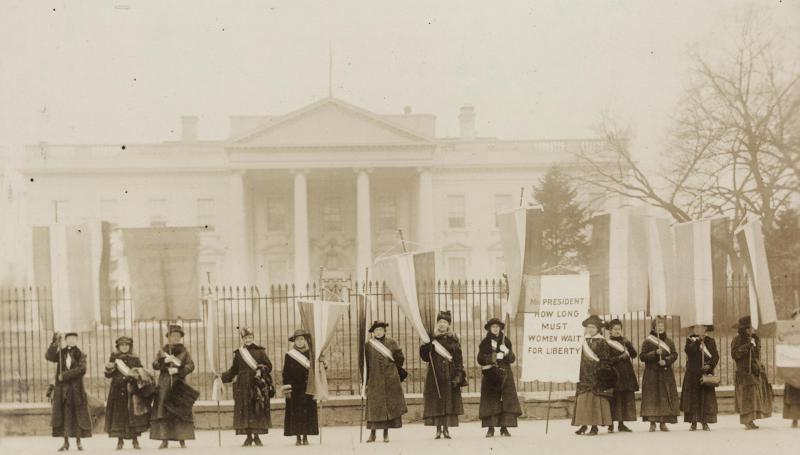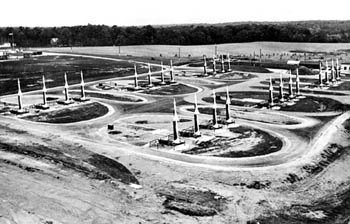
Fairfax County Public Library explores a dozen intriguing people and places from around the historic county.
By Lisa Kern, Branch Manager at Oakton Library
Formed in 1742, Fairfax County predates the signing of the Declaration of Independence and the start of the Revolutionary War by more than 30 years. Over the course of nearly 300 years, the county has been home to numerous notable residents and historic events.
The 455 historical markers that dot Fairfax County roadsides, parks, and other local sites commemorate many of those individuals and occasions. Some describe well-known people and places like Clara Barton, Manassas, Mount Vernon, the Battle of Ox Hill, Mosby’s Raiders and Lord Fairfax.
Other markers, however, tell the stories of lesser-known figures and events, providing a treasure trove of historical gems that might surprise and intrigue many a local resident. Read on to discover a dozen of the more obscure and fascinating markers of Fairfax County — selected from the Historical Marker Database — along with their descriptions. Check out the full listings at HMdb.org, and learn more about local and regional history by tapping into the resources of the Virginia Room, a special collection of history and genealogy within Fairfax County Public Library.
The Big Fire | Herndon
On the night of March 22, 1917, a fire that started at a nearby livery stable consumed downtown Herndon, including a portion of Station Street and much of Pine Street. Although the use of dynamite prevented further devastation, 14 buildings were lost. This fire served as the catalyst for the purchase of fire equipment and the later formation of the Herndon Volunteer Fire Department.
Ferenc Nagy | Herndon
The founding father of Hungarian democracy and a civil rights leader, Nagy lived in Herndon from 1947 to 1979. Elected in Hungary’s first democratic election, he served as prime minister of Hungary from February 1946 to May 1947, resisting attempts by the Hungarian Communist Party to become a puppet of a Soviet backed police state. In 1947 he resigned under duress (the kidnapping of his son) and gave up the premiership in return for his son and 300,000 Swiss francs. He was subsequently granted asylum in the United States.
Florence Jodzies | Oakton
In 1934, at her home Harmony Farm in Oakton, Florence Jodzies founded the Vale Home Demonstration Club, affiliated with the Virginia Cooperative Extension Service. An excellent speaker and writer, Jodzies campaigned for better living conditions in rural communities, including the need for improved roads, indoor plumbing and access to recreational facilities. In 1936, as state library chairman of the Virginia Federation of Home Demonstration Clubs, she developed the Federation’s library project to bring books, magazines and literature to rural Virginians. Designed to “bring improvement of mind and refreshment of soul” to members and their communities, by 1938 the project was adopted by clubs throughout Virginia.
Hybla Valley Airport | Alexandria
Virginia’s first airport permit was granted to Elvin W. Robertson’s Hybla Valley Airport in February 1929. As president of Mount Vernon Airways, Robertson utilized the airfield as a site for barnstorming and air circuses. Robertson, Fairfax Supervisor Chairman W.F.P. Reid, and the president of Germany's Zeppelin Company envisioned the field as an ideal airport for the Hindenburg’s passenger and mail service. Additionally, the site was a contender for the Washington, D.C., regional airport. During World War II U.S. Navy pilots trained at Hybla Valley, and government surplus aircraft were sold there. Ashburn Flying Service operated the field from 1945 until its closing 1956.
Ilda | Annandale
Ilda, a community located at the intersection of Guinea Road and Little River Turnpike, came into existence after the Civil War and lasted into the first half of the twentieth century. It originated when two freedmen — Horace Gibson and Moses Parker — purchased property on the north side of the turnpike from the Gooding family and established a blacksmith shop. In time, a racially mixed community grew to include a post office. According to tradition, the name “Ilda” was a contraction of the name Matilda Gibson Parker. Descendants of Gibson and Parker were probably buried in a nearby cemetery, perhaps originally created to accommodate people enslaved by the Gooding family. Their remains were relocated in 2008.
Ira Noel Gabrielson | Oakton
Oakton resident Dr. Ira Noel Gabrielson was a pioneer conservationist, distinguished field ornithologist and renowned author. He served as the first director of the U.S. Fish and Wildlife Service and was an international leader of conservation projects. Gabrielson founded and served as the first chairman of the Northern Virginia Regional Park Authority and first President of World Wildlife Fund-US. For his life’s work, he was inducted into the National Wildlife Federation’s Conservation Hall of Fame in 1978. His land, between Leeds Road and Difficult Run, is a Fairfax County park known as Gabrielson Gardens Park.
Laura Ratcliffe | Herndon
Confederate spy Laura Ratcliffe was born in Fairfax County in 1836. During the Civil War she met Maj. Gen. J. E. B. Stuart, who introduced her to then-Lt. John Mosby in 1862. Mosby credited her with preventing his capture early in 1863, noting, “My life as a partisan would have closed that day.” Ratcliffe and other informants provided Mosby and his Partisan Rangers (43d Battalion, Virginia Cavalry) information that helped them raid Union outposts, communications and supply lines. She married Milton Hanna in 1890. Ratcliffe died in 1923 and is buried nearby in a family cemetery.
Mystery of the Centreville Six | Centreville
In June 1994, a well-preserved male skeleton was found buried in a then-wooded area and reported to authorities. Remnants of a woolen uniform jacket with military-style brass buttons covered the upper half of the remains. Three years later, forensic anthropologists and archaeologists from the Smithsonian Institution and Fairfax County Archaeological Services explored the site further and found five additional burials, all in a row. After extensive examination of forensic data, as well as genealogical and military records, researchers concluded that the men were among the earliest casualties of the Civil War. They died during or after a fight at Blackburn’s Ford July 18, 1861, when Confederates under Gen. James Longstreet blocked a Federal column under Daniel Tyler that attempted to cross Bull Run. On June 10, 2006, the six soldiers were reinterred with full military honors in the Massachusetts National Cemetery in Bourne, Massachusetts.

Nike Missile Sites | Fairfax, Great Falls and Lorton
During the Cold War, a ring of Nike anti-aircraft missile sites defended the nation’s capital, reminiscent of the perimeter of forts that protected it during the Civil War. The launch control equipment for one of the three Nike complexes in Fairfax County was located just east of Fairfax. To the west stood the missiles, poised on above-ground launchers. The U.S. Army (1954–1959) and the Army National Guard (1959–1963) operated the battery. Built to oppose Soviet air attack, this complex and those in Great Falls and Lorton were three of 13 Nike sites that surrounded Washington and Baltimore.
Occoquan Workhouse | Lorton
In the Occoquan Workhouse, from June to December 1917, scores of women suffragists were imprisoned by the District of Columbia for picketing the White House demanding the right to vote. Their courage and dedication during harsh treatment aroused the nation to hasten the passage and ratification of the 19th Amendment in 1920. The struggle for woman’s suffrage had taken 72 years.
Thermo-Con House | Fort Belvoir
In 1948, the Department of Defense worked with Higgins Industries to develop a standard house design to meet the Army’s housing shortage. Higgins Industries designed and mass-produced landing craft during World War II and held the patent for “Thermo-Con,” a cement material that expanded as it cured. The renowned industrial architects Albert Kahn & Associates designed the prototype in the International style, and the 410th Engineer Battalion completed the building in 1949. Due to its innovative design and construction techniques, the house was placed on the Virginia Landmarks Register in 1997. In 2000, the Army renovated and returned ‘Thermo-Con’ House to use as distinguished visitor housing.
WWII POW Camp Site | Fairfax
One of seven work camps in the commonwealth of Virginia, a state road work camp located in the vicinity of this site housed 199 German prisoners of war from July to November 1945. Prisoners worked on local farms to alleviate the labor shortage associated with the war. On November 16, 1945, following the end of the war, all work camps closed and the prisoners were sent to Camp Shanks, New York, before eventually returning to Germany. The marker can be reached from the intersection of Government Center Parkway and Ridge Top Road, across from the parking entrance to apartments and retail on Ridge Top Rd., behind the storage facility.

